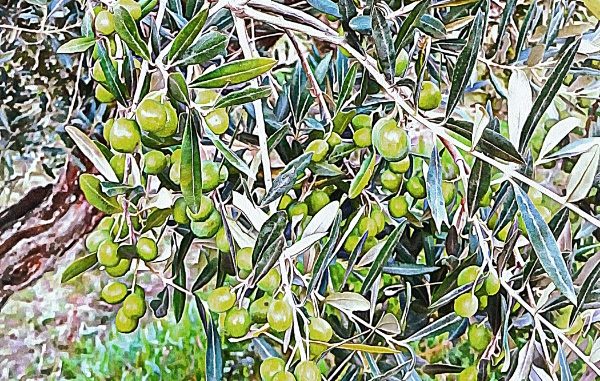
Olives to oil – our annual fun and games to produce an olive crop for oil. And this year I used an umbrella!
Olives to Oil
We don’t have a lot of olive trees. But we are lucky to have a small olive grove of 12 trees just below the garden area of the house. There are five more olive trees grown as fencing on another part of the land and seven trees grown as espaliers to provide screening and privacy. The main olive production takes place in the olive grove. Three of the trees there are quite young so they are not yet producing much. Four of the trees crop quite well regularly, the others are a bit hit and miss. Probably due to my pruning!
We often get asked whether we grow them to eat and the answer is no. I remember a visitor once racing out and picking a ripe olive off the tree and trying to eat it. Only to spit it out in disgust at the bitterness. To get the lovely olives we enjoy eating takes a lot of time. Anything from three to 12 months of curing in brine! There are other methods of curing but that is the main one.
We live in an olive oil production zone so we grow our olives for oil.
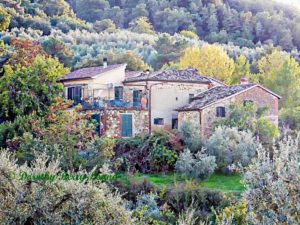
Annual Pruning
Time of Pruning
We prune our olives in spring. That used to be the traditional time around here to do so. Most of our neighbours grow olives – in fact our immediate neighbour has 10,000 trees. But in recent years some people have pruned their olives just after picking in October/November. We tend to stick with our traditional approach. After all it is much nicer to prune the trees in warm sunshine than when it is cold and blowing a gale!
The Aim Of Pruning
The main aim of olive pruning is to open up the branches to the light by taking out those that are ingrowing or cross over. Olives are produced mainly at the top and on the outside of the tree. After all these years, and being shown how to do it, I still haven’t got it right! I remember an Italian neighbour stopping by once and asking me what my olive trees had done to deserve the scalping I had given them. But the trees are very forgiving and grow quickly.
Watching The Growth
After the pruning we settle into a long period of just watching and waiting. Well actually, we don’t do either. With the long hot summer we have plenty of other things to do than watch our olive trees grow. Though it would work nicely as a meditative practice! Usually one day I notice that flower buds have started to appear on the trees. Then little racemes of flowers appear.
This is one of the danger times. If there is heavy hail storm these flowers can be easily knocked off, decimating the olive crop. Eventually the flowers give way to tiny fruits that begin to form and gradually get bigger. No-one really relaxes until the fruits start to look like small olives.
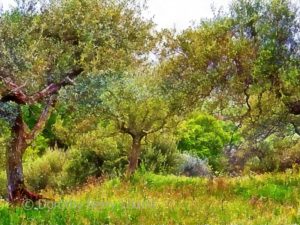
Past Problems
The last few years there have been all sorts of problems with the olives locally. Pests and disease have meant that no olives were picked for a while. Up until that point we had picked every year and used our own olive oil in the kitchen. Then last year I was in hospital right at picking time and didn’t recover in time. So we left the olives to the birds and the deer!
Getting Ready To Pick
As the end of September looms and the heat of summer starts to recede we begin to start thinking about our olive harvest. At this point it just means getting the grass cut around the trees to make picking easier and making sure we have all our tools ready.
In Days Gone By
In years past, picking olives on the big farm that neighbours us was almost a community event. The pickers and their wives would sit with the nets spread out, looking for holes and mending them. They would bring and share food and wine and it would have a party atmosphere. This would all be done ready for starting to pick.
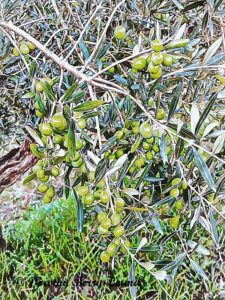
Picking The Olives
Hand Picking
Years ago, the big nets would be spread under the trees and the pickers would work in small groups using a wood olive ladder to reach the high branches. Olives were picked by hand and/or using hand rakes.
Modernization Of The Picking Process
These days modernization has come to the local farm and two large olive picking tractors do most of the work. They have a large arm that grabs hold of the trunk of the olive tree. Then bat like wings come out of either side of the tractor and go round the tree forming a canopy to catch the olives. The tractor then shakes the tree – it is a bit fierce and quite noisy! Meantime a couple of workers hit the tops of the tree with long sticks. The olives fall into the tractor canopy and are channelled into a container.
For those with fewer trees, you can now get mechanical shakers that are like rakes on long handles. They attach to a battery and the head rotates to knock the olives off the trees. I saw a guy who had one of these attached to his car battery. His car was parked at the side of the road with the bonnet open and leads attached. I hope the car started when he had finished picking!
Picking Our Trees
We still pick ours by hand. I did try to use a hand rake once but I didn’t like it. I like the feel of the tree and I think it is much gentler an approach. It makes your hands a bit sore but they end up lovely and soft from the oil. You get less leaves mixed in with the olives as you can be a bit more selective than the mechanical process. Picking involves gently pulling your cupped hand down the length of a branch, knocking off the olives so they fall. And this is where the umbrella comes in.
An Umbrella Instead Of An Olive Net
Our trees are so close together and the ground is very uneven which makes using an olive net a complete pain – I know we have used them in the past. To stop the olives disappearing down the hill you have to use lots of sticks to hold up the end of the olive net. In some places the net would have to hang at right angles in brambles.
When I couldn’t sleep one night I had the idea to use an old umbrella. I imagined it open but upside down with the spike in the soil, placed under the tree so that the olives fell into it. And you know what? It worked!
Three Leisurely Days Of Picking
I can’t stand and pick for long but it is amazing what you can do in an hour. And it is quite therapeutic. I try to pick mindfully and enjoy the interaction with the trees. An hour at a time with a rest in between we managed to pick our small olive crop over three days and ended up with three crates of olives. I am sure a fitter person could do the lot in one day. But we enjoyed doing it and we had such a sense of pride when we looked at our olives in the crates.
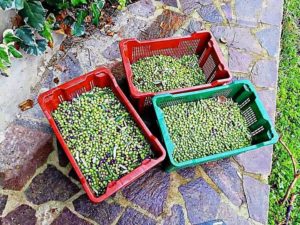
The Mill
The next process of olives to oil involves a visit to the local olive mill. Our crop is not big enough to justify a pressing on its own so we put ours into a co-operative. At least we know that some of the oil we get comes from our olives.
Weighing In
At the mill our crates are put on weighing scales and a note is made of the weight. Then the olives are emptied into a larger container and the our empty crates are weighted. That figure is taken off the original and that is the recorded olive weight. And this year it was 50 kilos. We are given a slip with the details on and told when we can go and collect our oil. This year it was 15 days later.
How Much Oil Do You Get?
Much depends on the quality of the olives in terms of how much oil you get. In a really good year, 5 kilos of olives could make one litre of oil. This year the rend was not so good but we still got 5.5 litres of olive oil. Funnily enough it is all done in weight. We actually got 5 kilos of oil. With oil being heavy one kilo of oil is equivalent to 1.1 litres. We collected our oil in a plastic container and then immediately decanted it into the pre-prepared one litre bottles we use every year. Washed and dry, obviously.
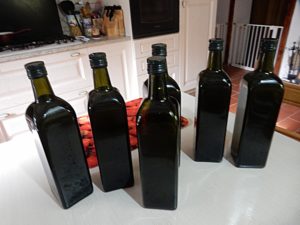
Storing The Olive Oil
Olive oil degrades over time so the bottles that are used, the seal and storage conditions all make a difference. The oil has to be protected from air and light (and shouldn’t come into contact with metal). The bottles we use are dark green glass and they are well sealed. Then the bottles are stored in a cool, dark place.
Olives To Oil – The Cost
We don’t have much financial outlay for this exercise. Everything is used year after year. Except for the umbrella which was an old one that no longer functioned with broken spokes and ragged edges. It was repurposed as an olive collector but will have to be replaced next year. The only actual financial cost is the charge for milling. In our case that was €8. So the cost of the olive oil to us is in the region of €1.45 per litre. To buy a litre of newly pressed olive oil would actually cost €10. So I think given the pleasure we have from the results of our hard work it is well worth it. Don’t you?
Before you go

My name is Dorothy Berry-Lound an artist and writer. You can find out more about my art and writing at https://dorothyberryloundart.com.
You can follow me on Facebook.
Thank you for reading!

Leave a Reply